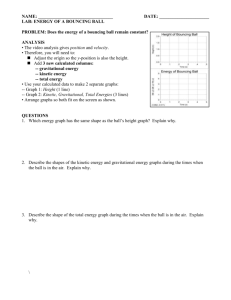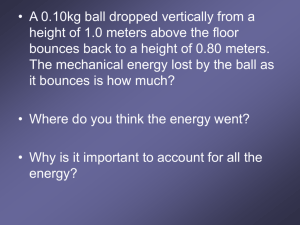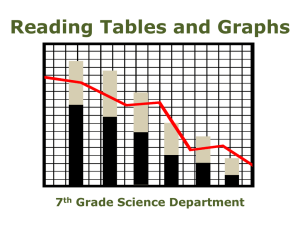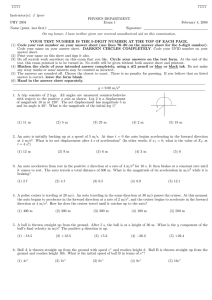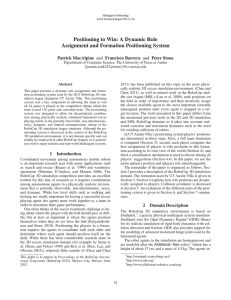File
advertisement
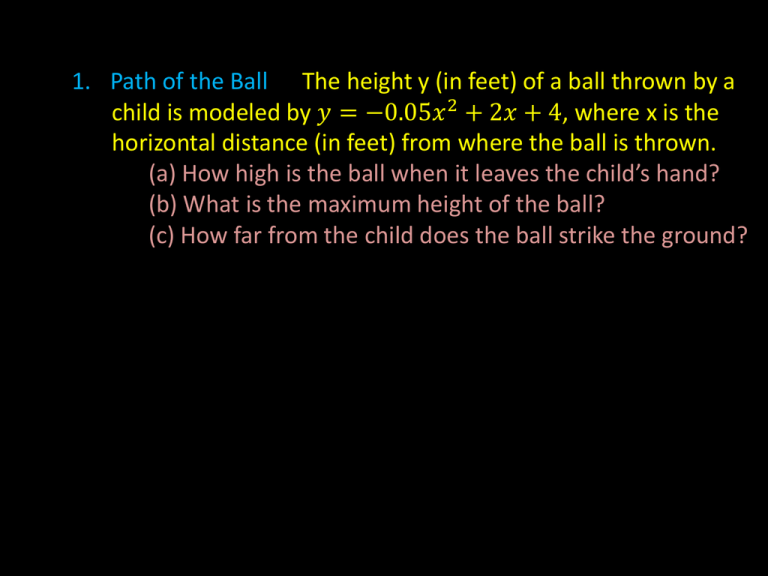
1. Path of the Ball The height y (in feet) of a ball thrown by a
child is modeled by 𝑦 = −0.05𝑥 2 + 2𝑥 + 4, where x is the
horizontal distance (in feet) from where the ball is thrown.
(a) How high is the ball when it leaves the child’s hand?
(b) What is the maximum height of the ball?
(c) How far from the child does the ball strike the ground?
Review: 10.4 Mini-Quiz
1. Consider the graph of
a. Write the equation of the axis of symmetry.
b.
Find the coordinates of the vertex.
c.
Graph the function.
Review: 10.4 Mini-Quiz
Consider the graph of
c.
Graph the function.
Answer:
Class Greeting
Chapter 10
Quadratic Equations and Functions
Lesson 10-7a
Relations Functions and Graphs
Objective: The students will be able to
define a relation; identify the domain
and range of a relation; represent
relations as tables, graphs, and
mappings; determine if relations are
functions; and evaluate functions for
given values.
Relations
In mathematics, relations are commonly described by
ordered pairs of numbers. The set of x-coordinates is the
domain, and the set of y-coordinates is the range.
In the relation {(3,5), (1,2), (4,4), (0,3)}, the domain D and
range R are the sets D = {3, 1, 4, 0} and R = {5, 2, 4, 3}.
1. Determine the domain and range for the relation
{(4, 3), (–2, –1), (–3, 2), (2, –4), (0, –4)}.
The Domain is x and the Range is y.
Answer: Domain: {–3, –2, 0, 2, 4}
Range: {–4, –1, 2, 3}.
Represent a Relation
Express the relation {(4, 3), (–2, –1), (–3, 2), (2, –4), (0, –4)} as a
table, a graph, and a mapping.
2. Table
3. Graph
Graph each ordered pair on a coordinate plane.
(-3,2)
(4,3)
(-2,-1)
(2,-4)
(0,-4)
4. Mapping
List the x-values in set X and the y-values in set Y. Draw an
arrow from the x-value to the corresponding y-value.
Identify Functions
5. Determine whether the relation is a function.
Explain.
Answer: This table is a function
because every x has
only one y.
6. Determine whether the relation is a function.
Explain.
Answer: This is a function because every x has only
one y.
7. Determine whether the relation is a function. Explain.
Answer: This is a function because every x has only
one y.
8. Is this relation a function?
Explain.
A. No; because x = 3 more than one time.
B. No; because there are negative values in the
range.
C. Yes; because it is a line when graphed.
D. Yes; because it can be represented in a chart.
9. Is this relation a
function? Explain.
A. No; because x = 3 more than one time.
B. No; because there are negative values in the
range.
C. Yes; because it is a line when graphed.
D. Yes; because it can be represented in a chart.
Equations as Functions
10.
Vertical Line Test
A. yes
B. no
C. not enough
information
11.
A. yes
B. no
C. not enough information
Function Values
12. If f(x) = 3x – 4, find f(4).
In function notation, y is replaced with f(x) read “f of x”
f(4) = 3(4) – 4
f(4) = 12 – 4
Answer: f(4) = 8
Replace x with 4.
Lesson Summary:
Objective: The students will be able to
define a relation; identify the domain and
range of a relation; represent relations as
tables, graphs, and mappings; determine
if relations are functions; and evaluate
functions for given values.
Preview of the next Lesson:
Objective: The students will solve real
world word problems using Relations,
Functions and Graphs.
Homework
609-611/ 5-39 odd
Stand Up Please





